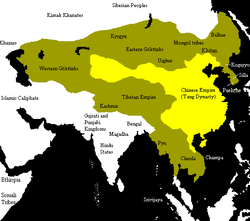| Revision as of 21:51, 6 March 2009 editTeeninvestor (talk | contribs)Pending changes reviewers8,552 editsNo edit summary← Previous edit |
Revision as of 23:01, 6 March 2009 edit undoYaan (talk | contribs)Extended confirmed users, Pending changes reviewers8,934 edits No reason two mention non-disjoint areas separately, I think. And Eastern Mongolia is really marginal compared to Middle Asia.Next edit → |
| Line 5: |
Line 5: |
|
|
|
|
|
'''Inner Asia during the Tang Dynasty''' was characterized by serial wars of expansion. |
|
'''Inner Asia during the Tang Dynasty''' was characterized by serial wars of expansion. |
|
In the 7th to 8th centuries, the ] Chinese expanded across large areas of the steppes of Central Asia; and for more than a century, the Tang retained control of Central Asia and eastern part of modern Mongolia and parts of Inner Asia.<ref>] (LOC):: </ref> This Chinese hegemony was not unopposed at its periphery. ]'s military success was, in part, a consequence of changes he initiated in the Chinese army, including improved weaponry. The emperor placed a new emphasis on cavalry, which was very important because his non-Chinese opponents used the horse effectively in warfare.<ref>Latourette, Kenneth Scott. (1965). </ref> |
|
In the 7th to 8th centuries, the ] Chinese expanded across large areas of the steppes of Central Asia; and for more than a century, the Tang retained control of large parts of Central Asia. This Chinese hegemony was not unopposed at its periphery. ]'s military success was, in part, a consequence of changes he initiated in the Chinese army, including improved weaponry. The emperor placed a new emphasis on cavalry, which was very important because his non-Chinese opponents used the horse effectively in warfare.<ref>Latourette, Kenneth Scott. (1965). </ref> |
|
|
|
|
|
The Khitan in the eastern Mongolia and southern Manchuria made their submission to the Chinese in 630.<ref>Latourette, Kenneth Scott. (1934). </ref> In the recurrent process of sinicization, Khitan chieftains established themselves as emperors of northern China; their rule was known as the ] (916-1125)<ref>LOC: </ref> in eastern Mongolia, Manchuria, and northern China.<ref>LOC: </ref> |
|
The Khitan in the eastern Mongolia and southern Manchuria made their submission to the Chinese in 630.<ref>Latourette, Kenneth Scott. (1934). </ref> In the recurrent process of sinicization, Khitan chieftains established themselves as emperors of northern China; their rule was known as the ] (916-1125)<ref>LOC: </ref> in eastern Mongolia, Manchuria, and northern China.<ref>LOC: </ref> |
The Khitan in the eastern Mongolia and southern Manchuria made their submission to the Chinese in 630. In the recurrent process of sinicization, Khitan chieftains established themselves as emperors of northern China; their rule was known as the Liao Dynasty (916-1125) in eastern Mongolia, Manchuria, and northern China.
